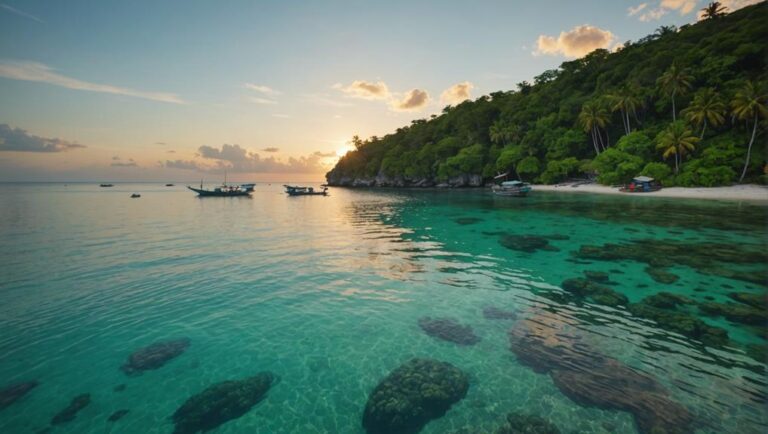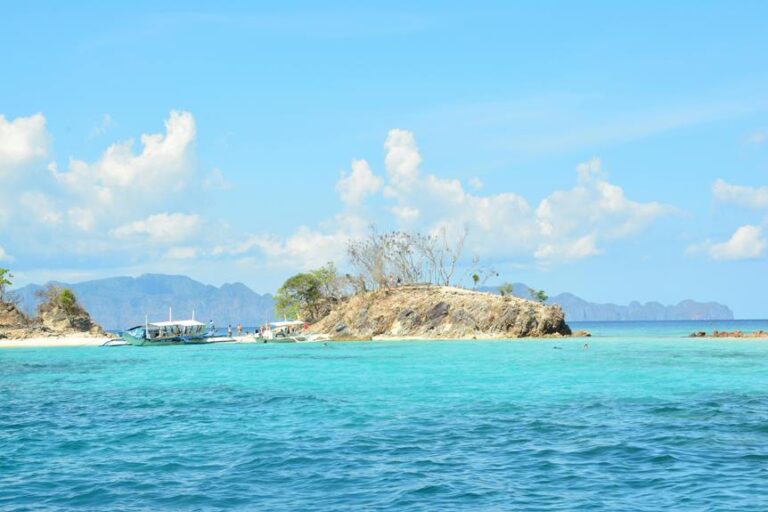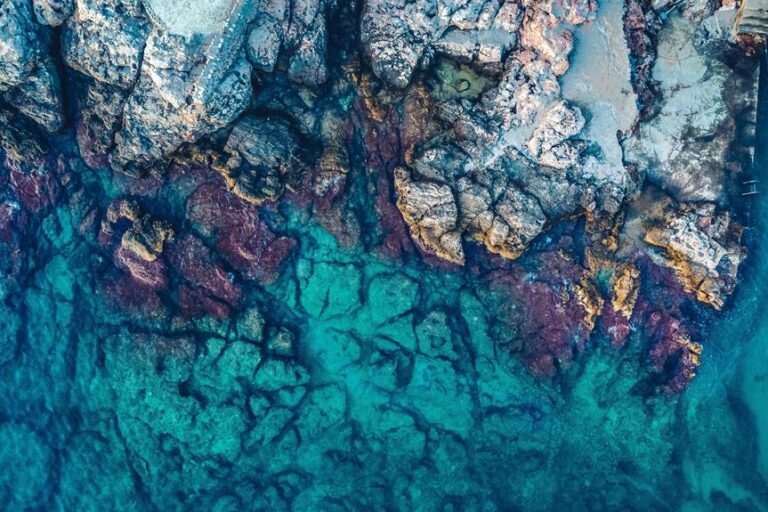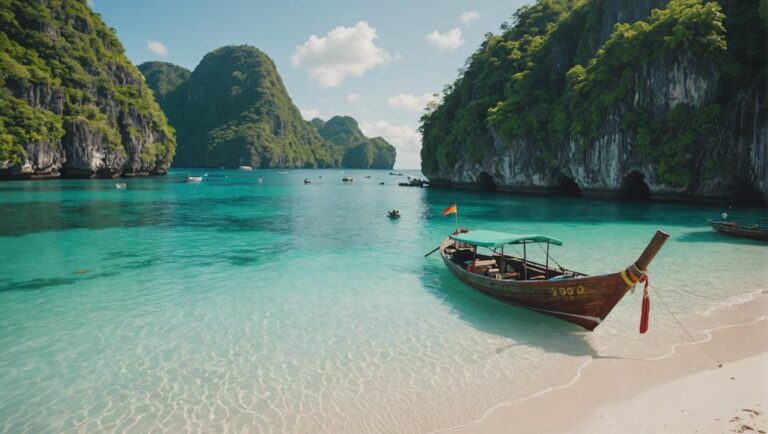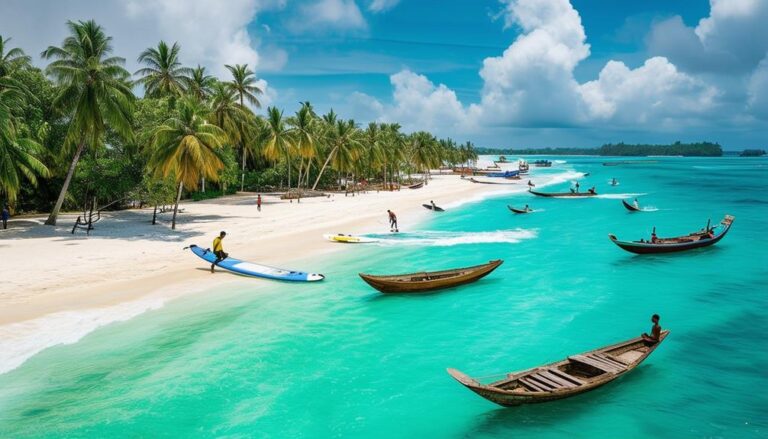Mayon Volcano Philippines
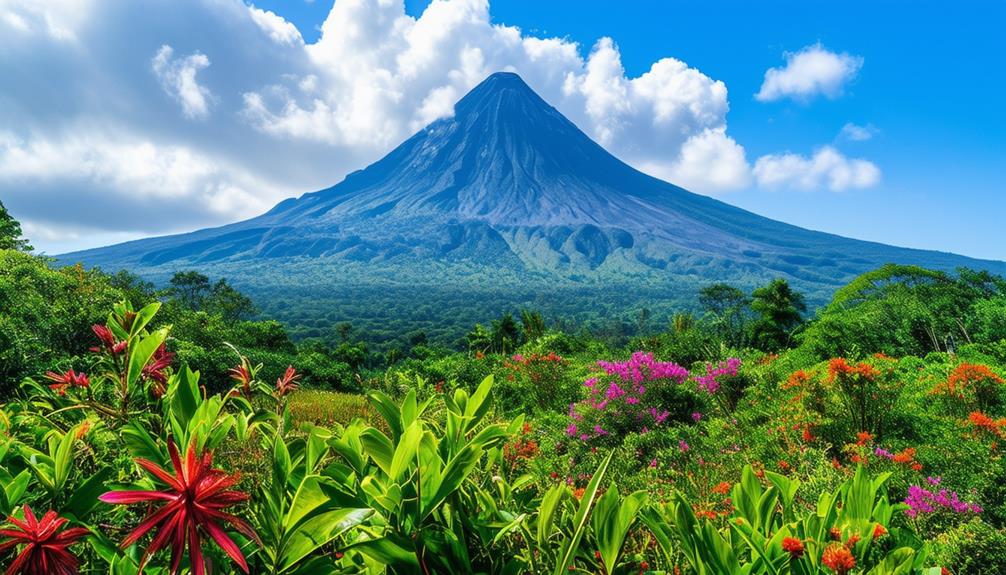
The Mayon Volcano in the Philippines, is an iconic stratovolcano renowned for its almost perfect cone shape, standing at 8,077 feet. This geological marvel results from layered lava flows and pyroclastic surges, characteristic of the Pacific Ring of Fire.
It has erupted over 30 times since 1616, causing significant human and environmental impact most outstandingly in the 1814 and 2006 eruptions. The Mayon Volcano Natural Park spans 21 square miles, featuring diverse ecosystems and historical sites like the Cagsawa ruins.
Adventure activities like hiking and ATV tours reveal its rugged landscape and volcanic features. Explore further to uncover its rich cultural and geological insights.
Key Takeaways
- Mayon Volcano is located in the Bicol Region of the Philippines and is known for its perfect cone shape.
- It stands at 8,077 feet and is recognized as the world’s most perfectly formed volcano.
- The volcano has erupted over 30 times since 1616, posing significant risks to nearby communities.
- Mayon Volcano Natural Park, covering 21 square miles, offers diverse ecosystems and historical sites like Cagsawa.
- Adventure activities around Mayon include ATV tours, hiking, and exploring its extensive lava fields.
Mayon Volcano Philippines At A Glance
| Fact | Details |
|---|---|
| Location | Bicol Region, Philippines |
| Height | 8,077 feet (2,462 meters) |
| Shape | Symmetrical stratovolcano with an almost perfect cone shape |
| Designation | Declared as the first National Park of the Philippines in 1938 |
| Volcano Type | Active stratovolcano, part of the Pacific Ring of Fire |
| Eruption History | Over 50 recorded eruptions since 1616, with major eruptions in 1814, 1993, 2006, and 2018 |
| 1814 Eruption | Considered the most destructive, burying the town of Cagsawa and causing around 1,200 deaths |
| 2006 Eruption | Combined with Typhoon Durian, causing deadly mudslides and floods, resulting in over 1,000 deaths |
| Mayon Volcano Natural Park | Covers an area of 21 square miles (54 sq km), featuring diverse ecosystems and historical sites like the Cagsawa ruins |
| Adventure Activities | ATV tours, hiking, exploring lava fields |
| Cultural Significance | Named after the legendary princess-heroine Daragang Magayon, with local festivals and rituals celebrating the volcano |
| Interesting Facts | Considered one of the world’s most perfectly formed volcanic cones; over 30,000 people live within the permanent danger zone; fertile volcanic soils support agriculture |
Perfect Symmetry and Beauty
With its perfect cone shape rising to 8,077 feet, Mayon Volcano‘s symmetrical profile is a result of millions of years of layered lava flows and pyroclastic surges. This geological wonder, located in the Philippines, isn’t just a visual marvel but a proof of the dynamic processes shaping our planet. The volcano’s iconic appearance, characterized by its steep upper slopes averaging 35 to 40 degrees, adds to its majestic allure and draws tourists from around the globe.
Declared the first national park of the Philippines in 1938, Mayon’s status underscores its geological and environmental significance. The perfect cone shape you observe today is a product of repeated eruptions, depositing alternating layers of viscous lava and fragmented pyroclastic materials. These layers have built up over time, creating the volcano’s symmetrical profile that stands as a symbol of natural perfection.
Tourists are captivated by Mayon’s beauty, and their visits contribute greatly to the local economy. The unique opportunity to explore the surrounding lava fields, engage in ATV tours, and hike up to Camp 2, despite summit restrictions, offers an immersive experience of the volcano’s fascinating geological history. Such activities not only enhance the tourist experience but also provide economic benefits to the local communities.
The upper slopes of Mayon, with their steep inclines and consistent angles, further enhance the volcano’s iconic appearance, making it a subject of numerous photographs and studies. As you venture into this national park, you’ll witness the seamless blending of natural beauty and geological complexity, highlighting why Mayon Volcano is a must-visit destination for nature enthusiasts and adventure seekers alike.
Geographic Wonders
Mayon Volcano’s geographic wonders are exemplified by its perfect cone shape, towering height of 8,077 feet, and expansive base circumference of 80 miles, making it a remarkable landmark in southern Luzon, Philippines. Located in the Bicol Region, this iconic stratovolcano isn’t only a natural marvel but also a subject of scientific interest due to its active status within the Pacific Ring of Fire.
The symmetry of Mayon’s cone is unparalleled, earning it recognition as the ‘world’s most perfectly formed volcano.’ This geometric precision is a result of consistent eruptive activity that deposits layers of pyroclastic materials and lava flows, shaping a near-perfect cone over centuries. The surrounding Mayon Volcano Natural Park, encompassing 21 square miles, offers a diverse ecosystem, featuring abaca plantations, dense forests, and various endemic species.
The park provides a unique vantage point to observe Mayon’s geological features. You’ll find the ruins of Cagsawa, a historical site buried by lava flows from the catastrophic 1814 eruption, illustrating the dynamic interplay between volcanic activity and human settlement.
The region’s topography, influenced by numerous eruptions, includes lava fields, pyroclastic deposits, and volcanic debris, contributing to the area’s rich soil fertility.
Mayon is deeply embedded in the local culture and folklore, epitomized by the legend of Daragang Magayon. This cultural dimension adds a layer of anthropological interest to the geographic study of the volcano. Additionally, its location in Albay positions it as a focal point for seismic activity monitoring, given its status within the Pacific Ring of Fire.
Analyzing Mayon’s geographic wonders offers insight into volcanic formation processes, ecosystem diversity, and the impact of volcanic activity on human communities.
Eruptive History
Since 1616, Mayon Volcano has erupted over 30 times, demonstrating a consistent pattern of volcanic activity that poses significant risks to nearby communities. Located in the Philippines, Mayon Volcano’s eruptive history is marked by numerous continuing eruptions, some of which have been particularly catastrophic.
A major event in Mayon’s eruptive history occurred in 1814, when a lethal eruption buried the town of Cagsawa, resulting in approximately 1,200 casualties. This big eruption is often cited as a stark reminder of the volcano’s potential for destruction.
In more recent times, Mayon has maintained its reputation for volatility. The 1993 eruption caused 79 fatalities and necessitated large-scale evacuations, heavily impacting the lives of residents in the surrounding areas. Another significant eruption occurred in 2006, which, combined with Typhoon Durian, caused devastating mudslides and floods, leading to over 1,000 deaths.
Key eruptions in Mayon’s history:
- 1814: The most destructive eruption, burying Cagsawa and causing around 1,200 deaths.
- 1993: A deadly eruption resulted in 79 fatalities and massive evacuations.
- 2000: Marked by significant pyroclastic flows, leading to extensive property damage.
- 2006: Combined with Typhoon Durian, caused lethal mudslides, resulting in over 1,000 deaths.
- 2018: Recent activity that highlighted the volcano’s continuing eruptions and the ongoing threat to local communities.
Analyzing the eruptive history of Mayon Volcano reveals a pattern of frequent and often deadly activity. These eruptions underscore the importance of rigorous monitoring and disaster preparedness to mitigate the impact on the densely populated areas around the volcano.
Exploring Lava Fields
Trekking through Mayon’s expansive lava fields offers an unparalleled opportunity to directly observe the geological aftermath of its frequent eruptions. These fields, shaped by countless volcanic activities, extend like a rugged, otherworldly landscape that beckons geologists and enthusiasts alike. The lava fields surrounding Mayon Volcano in the Philippines are proof of the destructive yet creative power of volcanic activity.
When you start on one of the guided tours, you’ll traverse terrains that showcase the stark contrast between solidified lava flows and the burgeoning flora that fights for survival in this harsh environment. The terrain’s composition includes basaltic and andesitic rocks, remnants of various eruptions that have shaped the region over centuries. Each layer of rock tells a story of past eruptions, providing a tangible timeline of Mayon’s volcanic history.
Hikes through these lava fields are both educational and awe-inspiring. Experts leading these tours often discuss the formation of different volcanic features such as lava tubes, pahoehoe, and a’a lava. They also explain the ecological succession evident in these areas, where pioneering species gradually colonize the barren rock, signifying nature’s resilience.
Empirical evidence gathered from these lava fields also contributes significantly to our understanding of volcanic activity. Observational studies and sample collections help scientists predict future eruptions and mitigate potential hazards. The guided tours not only offer an in-depth look at the volcanic terrain but also underline the importance of ongoing research in volcanic regions.
Adventure Activities
While exploring the geological wonders of the lava fields provides a deep understanding of volcanic activity, the adventure activities around Mayon Volcano offer an exhilarating way to experience its majestic landscape. Located in the heart of Legazpi Philippines, Mayon Volcano’s adventure activities are designed to immerse you in the region’s natural beauty and rugged terrain.
- ATV tours around Mayon Volcano are a popular choice, allowing you to navigate the rugged paths and get an up-close view of the volcanic landscape. These tours offer a first-hand experience of the terrain formed by previous eruptions, enhancing your understanding of volcanic geology.
- If you’re looking for a more robust adventure, consider engaging in 4WD tours. These excursions take you deeper into the volcanic terrain, offering a more technical and thrilling exploration.
- To gain a thorough view of Mayon Volcano and its surroundings, the Ultimate Full Day Albay Bicol Philippines Tour is ideal. This tour not only covers the Mayon Skyline but also other attractions in the region, providing a comprehensive experience.
- For a shorter, yet equally enriching experience, the Legazpi Philippines Half Day Private Tour includes optional Mayon ATV adventures, offering flexibility in your adventure itinerary.
If you’re inclined to explore beyond Mayon, the Sorsogon Philippines Full Day Provincial Tour is a must. This tour features the picturesque Bulusan Lake and other natural wonders, giving you a broader understanding of the region’s geological diversity.
- ATV tours: Navigate rugged paths and volcanic landscapes.
- 4WD tours: Deeper exploration into the volcanic terrain.
- Ultimate Full Day Albay Bicol Philippines Tour: Thorough view of Mayon Skyline and local attractions.
- Legazpi Philippines Half Day Private Tour: Optional Mayon ATV adventures.
- Sorsogon Philippines Full Day Provincial Tour: Explore Bulusan Lake and more.
Cultural Significance
Mayon Volcano’s cultural significance is deeply rooted in local mythology and traditions, reflecting its essential role in shaping the identity of the surrounding communities. The volcano is named after the legendary princess-heroine Daragang Magayon, a figure who symbolizes beauty and resilience. This association enhances the cultural significance of Mayon, making it more than just a geological marvel but a pivotal element of local folklore.
Local mythology also ties Mayon to the supreme god Gugurang, who’s believed to reside within the volcano and safeguard the sacred fire. This belief underscores the profound impact of Mayon on local spiritual practices, imbuing the volcano with a sense of divine authority. The idea of the sacred fire represents both creation and destruction, encapsulating the dual nature of Mayon’s eruptions and fertile soil.
Festivals and rituals dedicated to Mayon further illustrate its enduring cultural importance. Events such as the Daragang Magayon Festival celebrate the legendary princess-heroine and the perfect beauty of the volcano. These cultural expressions serve as a medium for communal bonding and cultural identity reinforcement, ensuring that the stories and traditions surrounding Mayon are passed down through generations.
Moreover, the volcano’s presence has a profound impact on the daily lives and cultural practices of the local communities. Its majestic form is a constant reminder of nature’s power and beauty, shaping the cultural identity of those who live in its shadow.
Interesting Facts About The Mayon Volcano
- 🌋 The Mayon Volcano, located in the Philippines, is considered one of the world’s most perfectly formed volcanic cones, with its symmetrical shape and near-vertical slopes.
- 🔥 Despite its picturesque appearance, Mayon is one of the most active volcanoes in the Philippines, with over 50 recorded eruptions since the first recorded event in 1616.
- ⏳ Mayon Volcano has been active for over 400,000 years, making it one of the oldest active volcanoes in the world.
- 🏞️ The volcano is situated within the Albay Biosphere Reserve, a protected area recognized by UNESCO for its rich biodiversity and natural beauty.
- 🏘️ Over 30,000 people live within the permanent danger zone around Mayon Volcano, making them susceptible to potential eruptions and lahars (volcanic mudflows).
- 🌋 During its most violent eruption in 1814, Mayon’s eruption column reached an estimated height of 25 kilometres (15.5 miles), one of the highest ever recorded.
- 🌉 The famous Cagsawa Ruins, a church bell tower surrounded by lava rock, serves as a reminder of the destructive power of Mayon’s eruptions in the 18th century.
- 🏞️ The fertile volcanic soils around Mayon support a thriving agricultural industry, with crops such as coconut, abaca (Manila hemp), and pineapple being cultivated.
- 🌄 Mayon Volcano’s perfect cone shape and stunning backdrop have made it a popular subject for artists and photographers, earning it the nickname “Perfecto Cono” (Perfect Cone).
- 🗺️ The Mayon Volcano Natural Park, established in 1938, was one of the first national parks in the Philippines and attracts thousands of visitors each year for its scenic beauty and outdoor recreational activities.
Is it Safe to Visit Mayon Volcano if I’m Planning to Visit Vigan?
Yes, it is safe to visit Mayon Volcano if you’re planning to visit Vigan, Philippines. Mayon Volcano is located in Albay, while Vigan is in Ilocos Sur. Both are far from each other and have their own unique attractions. Enjoy your trip to Vigan Philippines and explore the beautiful Mayon Volcano.
Frequently Asked Questions
What Are 5 Interesting Facts About the Mayon Volcano?
You’re curious about interesting facts about the volcano. It has erupted over 30 times since 1616, features a perfectly symmetrical cone, stands 8,077 feet tall, buried Cagsawa in 1814, and includes Mayon Volcano National Park.
Is It Safe to Go to Mayon Volcano?
It’s generally safe to visit, but you should monitor real-time alerts from PHIVOLCS. Although the summit climb is restricted, other activities like ATV tours and hiking remain accessible, provided there are no imminent eruption warnings.
Is Mayon Volcano the Tallest Volcano in the Philippines?
No, Mayon Volcano isn’t the tallest in the Philippines. Mount Apo holds that title at 9,692 feet. Mayon stands at 8,077 feet but is renowned for its symmetrical cone shape and frequent volcanic activity.
Why Should You Visit Mayon Volcano?
You should visit for its geological significance and striking symmetrical cone. Despite climbing restrictions, ATV tours and hiking offer unique access to lava fields. Historical eruptions provide insights into volcanic activity, enhancing your understanding of natural phenomena.
Conclusion
Standing before the near-perfect symmetry of Mayon Volcano’s iconic cone, one can’t help but be awestruck by both its natural beauty and raw power. This geological marvel offers a unique opportunity to witness the incredible forces that shape our planet.
From exploring the rugged lava fields to thrilling ATV adventures, Mayon provides an immersive experience that blends adventure with scientific insights into volcanic activity. Despite the potential dangers, the volcano’s cultural significance and deep roots in local traditions ensure it remains an enduring source of wonder and fascination.

